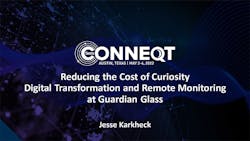Just as updating eyeglass prescriptions bring the world into sharper focus, longstanding data analytics solutions can be extended by new and more digitalized tools that identify details and opportunities that weren’t visible before.
For instance, Guardian Glass makes about 500 km of glass per day using 44 assets at its worldwide facilities. It floats raw materials on molten tin to produce flat glass ribbons, and coats them with microscopically thin layers of metal oxides and other performance-enhancing materials. These applications are remotely monitored by five engineers, including three in Michigan, one in Spain and one in the United Arab Emirates (UAE).
“Our two main processes are under different time domains of what’s important to us. Float glass lines run 18-20 years. Because we consume the materials that we sputter coat, those lines get taken down every six weeks for maintenance,” says Jesse Karkheck, remote process monitoring subject matter expert (SME) at Guardian Glass, during his presentation, “Reducing the Cost of Curiosity,” at Seeq’s Conneqt event in May in Austin, Texas. “With float glass, things happen slowly and it’s like steering a barge, which can take a week to course correct. With the coatings process, the devil’s in the details, and seconds to minutes are important to us. Each process presents very different challenges.”
Beyond trying to meet its usual performance goals, Karkheck reports that COVID-19 accelerated Guardian’s pursuit of remote monitoring. “We saw it as a good idea before the pandemic, but our previous state involved a lot of onsite firefighting with siloed data collected at each site that wasn’t used efficiently, extended upsets with long SME travels times, and painful data analysis,” says Karkheck. “We went into the pandemic with a very small pilot PI system of about 10,000 tags. However, when suddenly no one could travel, they got the idea that remote monitoring could be a big deal for running experiments and keeping production going. We focused on remote capabilities, and accessed unlimited, widespread, real-time enterprise data via PI System software. This changed the resolution and availability of the data, and went from some plants getting data points every 20 minutes to getting them every couple of seconds.”
Picking the right problem
“Good ideas aren’t always well-defined projects,” adds Karkheck. “We have a lot of smart people in our facilities, but people are busy, and we have a small remote monitoring team. Even though we have continuous production lines, that have batch aspects, so analyzing periodic conditions really became a challenge. We may have three years of data to analyze, but we need to pick out specific parts, such as thicknesses, product colors, production rates, and specific settings from engineers about data squirreled away in Excel sheets that could solve problems.” Karkheck also notes that Guardian’s approach to analytics addressed issues from engineers, who may keep data that could solve problems squirreled away in Excel sheets.
Karkheck states that Seeq lets it handle chemistry data, use production run dates that might not be in a historian, and help users with other potentially useful information. While a particular analysis test previously took three weeks with legacy tools, or one to three days with other software, Seeq delivered tests results in minutes with one profile search and less than 10 clicks, and lets users learn more.
“We didn’t really know we needed Seeq until we started using it,” says Karkheck. “We starting using it heavily at the beginning of the year, and it’s been organic growth ever since. I gave some people on my team the basic skills and it just took off. We want the cost of curiosity to be as low as possible because if you can lower the barrier to explore, you can try and discard many ideas, shift the pivot point, and find cool things. It’s common for us to be in remote monitoring meetings with the plants, and for them to bring up problem that started at some point, but they don’t know when. There may be five minutes left in the meeting, but they’ll give us some tidbits. We try to get them an answer before the meeting ends, and frequently we can determine when the problem started or where they should look.”
Slow, large transitions
Karkheck reports there are two main areas at Guardian’s plants where Seeq’s software is used: glass transitions and coater operating pressures. “With glass transitions, it was difficult to compare run-to-run data for products that are made infrequently, such as different colors that are produced about twice per year,” explains Karkheck. “Previous efforts took months to analyze, which meant they weren’t done or weren’t as thorough as they could be. The opportunity here is more than $1 million per plant for five plants.”
To evaluate its glass transitions more deeply, Karkheck adds that Guardian employs Seeq’s Chain View and Capsule View displays to compare runs, focus on the information it cares about, and leave out non-essential data. It examines data from multiple sources, including PI System, CSV files and SQL databases. “We were able to analyze three and a half years of data in just a few days with one person,” says Karkheck. “We’re still new with remote monitoring, and the plants are a little skeptical about outside help, but eventually their whole team shows up and asks us to review multiple issues. We got much better engagement with the plants by showing that we care and want to solve issues. We haven’t quantified the gains yet, but one plant just had the best run in their history.”
Conventional wisdom that all production runs are the same was contradicted by Chain View, which indicated temperature variations in some of Guardian’s product campaigns over the three and a half years studied. Meanwhile, Capsule View helps the glassmaker its process moving in the right direction from the beginning, which improves its glass transition’s chances for success.
Fast, small coating issues
Because its coating process happens more quickly, Guardian needs to maintain vacuum integrity in its vacuum sputter coaters, and identify clues about upsets before they can occur. “The challenge here is that we had some unexpected downtime with our previous toolset. We put a ton of work into these tools and they’re wonderful. They catch most of our issues, but there are still couple that slip by,” adds Karkheck. “And, when we looked closer at the data, there were small signs of issue that would normally be seen as noise.
“For example, our PI Vision Coater Check Engine display on all our vacuum coaters scans every second for a pump down, and rates vacuum integrity on every part of the coater. Consequently, while the regular KPI may say everything is at 100% for those couple of items that slip by, we used Seeq to flag specific conditions for the operating pressures when everything else is expected to be stable, though it may be for just a few seconds. In the end, we identified several small issues, reported them to the plant, and fixed them without incurring any downtime or bad product. A couple of years ago, before we had access to PI System and Seeq, this same issue went by undetected, and it caused more than $1 million in losses.”
Karkheck concludes that Seeq’s software found very short periods of unexpected pressure variations, and Chain View displayed them clearly, along with total gas flow and a running delta function of the point-to-point variability of incoming data. “So, any time we intentionally changed the gas flow, we expected to see a change in pressure, too. However, when we went to the Chain View, we also found short blips in pressure that shouldn’t be there. We took these to the plant, they adjusted their equipment settings without downtime, and this made the process more stable. We’ve been using Seeq’s software consistently for three or four months, and are finding many items like this, and saved about 200 hours of unplanned downtime on the coaters that are expensive to run.”
From onsite to servers
To extend these and other data analytics functions, Chris Herrera, senior principal solutions architect at Seeq, observes that cloud-computing providers are moving related services from onsite locations to servers. These include data gathering, edge computing, device management, adjust models and other services. “Users want to change their parameters for acquiring information or how they clean data before it goes to the cloud, so we’re starting to see them pick algorithms like automated machine learning (autoML) tools to brute force acquiring the right algorithm for their specific needs,” says Herrera. “This allows them to perform tasks like anomaly detection, handle multiple variables, or predict signals. Consequently, we recently launched the ‘Bring You Own Algorithm’ strategy that lets users leverage Seeq to run whatever algorithm they want, do computing at the edge or for a fleet, and view raw results or inferred calculated data in context.”
Herrera reports that cloud-based, algorithm-driven data analytics can help resolve one of the longstanding problems with analytics using comma-separated values (CSV) text files to deliver results on spreadsheets. “CSV files may not have the raw data that infers where information came from, which means data scientists and other users have to scroll through to put it in context, find a pattern, gain insights and enable decisions,” explains Herrera. “This is why our software makes follow-on inferences, so we can go where each user’s information is located, and generate data from there. We initially added remote agents and accessories to our software, and more recently included algorithm capabilities. This is useful because large facilities and processes may have 70 historians and 100 SQL servers, and it can be very costly to run and maintain data pipelines from all of them to a central location.
“We can also subdivide information into ‘capsules’ by time or other parameters, which Excel can’t do. This also makes it easier to calculate quickly because users no longer need to implement formulas in Excel, and find insights in time to positively affect performance and outcomes. One user reported that, when they open our Seeq Workbench software, the software infrastructure fades into the background, and it’s just them and the data they need to solve business problems.”
Jesse Karkheck, remote process monitoring subject matter expert (SME) at Guardian Glass, details six lessons and best practices that he and his colleagues learned while implementing Seeq’s Capsule View and Chain View data analytics software for remote monitoring glass transitions and coating processes at five of its plants:
- While corporate advice may not be initially appreciated by plants, solving issues that staffers care about will result in buy-in;
- Being a good listener is crucial because plants already know their pain points and the issues they’ve had, even if they haven’t had the tools to solve them;
- Investigate overlooked areas because users may have had thoughts about issues, but they likely didn’t have ways to investigate them;
- Look for problems that can be scaled and applied to other processes and facilities;
- Use the right tool for the right job because no single solution fit all applications; and
- Document and share results with monthly knowledge-sharing sessions or other events.
Data Analytics: Catching up to reality
This article is part of a series about data analytics. Read more here.
About the Author

Leaders relevant to this article:


